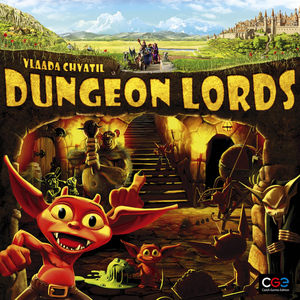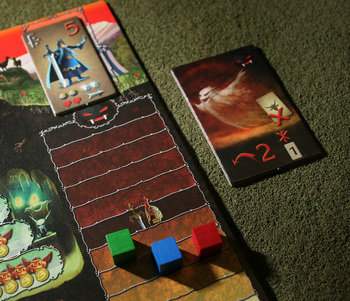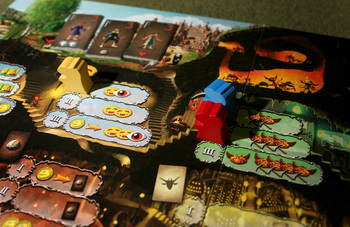Dungeon Lords: like planning a bizarre trip to the Secretary of State's Office

This wouldn't be much of a review column if I only reviewed games that I love, so let's look at one that, in my opinion, missed the mark: Dungeon Lords.
Dungeon Lords has a lot going for it. It has great art, great theme, and even a great rule book. But for me, the game just takes too long for what it is. But before we talk about everything that the game gets wrong, let's talk about the things that it gets right.
Dungeon Lords is a worker placement game, which means that the largest determiner of how well you will do is in how efficiently you manage your work force and the resources they bring you. Each player attempts to build a dungeon that can repel the pesky adventurers that would come to plunder it. Players use their imp workers to expand their dungeons and outfit it with the nastiest traps and monsters.

If the green player were to purchase the ghost monster for his dungeon, the symbol in the upper right shows that his marker would move one step more evil, putting him at the level where the paladin would come after his dungeon. Is the ghost worth fighting the paladin over?
Mike Hulsebus | Contributor
My favorite part of the game is the evil management mechanic. When you add certain strong or useful monsters to your dungeon, your evil rating goes up. The more evil your dungeon is relative to other players, the more adventurers that you'll attract. So you'll have balance picking good monsters without letting your evil get so high that word gets around to the tough adventurers, sending them your way. So while you want to vie for strong monsters, you have to make sure you don't get too evil or you'll lose all your advantage by having to pit those monsters against tougher foes. Furthermore, one player can't just go all-out evil or it will attract the attention of the incredibly strong paladin, a challenge that is hard to defeat.
My problem with the game is how the worker placement aspects of the game work (also known as the main mechanic of the game). See, each player has a certain number of minions that they can task with getting different resources. Each turn I choose three of the available actions based on what I want to get done. For action 1, I might choose to send a worker to get food. For action 2, I might try to lower my evil. For action 3, I might send someone to dig out more tunnels. I choose actions by selecting their corresponding card and putting it in a slot face down.

Because the red player placed the second minion on the tunneling action, he will have the advantage of being able to create three tunnels rather than only two like the blue player.
Mike Hulsebus | Contributor
Once everyone has chosen actions, each player reveals his choices and then goes around and places a worker on their actions in order, one slot at a time. Players receive a variable benefit based on if their minion arrived first, second or third to that action. So, for example, the first player that chose to lower evil lowers his evil by one space and gains another small effect. The second player gets to lower his evil by two spaces. The third player pays a gold to lower his evil by two spaces and get the small effect. In many cases, the player whose minion choose an action second gets the best effect. This basically makes the game impossible to plan out. I can deal with trying to figure out how likely I am to get somewhere first, but to figure out how to get there second? That complicates the game for no good reason.
Also don't be the fourth player to choose an action or you get nothing.
It's the real-life equivalent of trying to arrive at the Secretary of State when there is at least some line but not too long of a line. I know how to get there so I'm first in line: arrive early. But if I have no idea how to plan so that I could be fourth in line, giving me enough time to be called the moment that I finish filling out forms. And how would planning that out be worth my time?
That's the other main problem with Dungeon Lords: It takes too long. In a game that lasts about a hour and a half, I get to make about eight important decisions since there are only eight rounds that I get to pick actions for. And on top of that, I can sit there and try to plan out my actions, but it mostly seems pointless.
Am I giving the game a fair shot? Probably not. I have played only one game of Dungeon Lords, which I think is a cardinal sin of game reviewing. But if I'm going to play a strategic game multiple times, I would at least like for it to give me a good reason to try again. I didn't walk away saying “boy, if I could have played that last game again, I really wish I would have arbitrarily decided to put that food gathering action in slot 3 instead of slot 2.” The main learning curve of the game seems to be learning what rooms and traps are most valuable and hoping to pick the right actions to get them. After that point, I can't imagine the game is a game that players would want to pick up over other worker placement games. Feel free to let me know if you think otherwise or suggest better worker placement games in the comments.
Mike Hulsebus notes that the Terri Lynn Land would probably be good at worker placement games since the local office has been well staffed the past few times he's gone. He can be reached at mikehulsebus@gmail.com, but hopefully you'll email him second because he always deletes the first email he gets. Plan the timing of your email accordingly.

